Blog
Building an attractive and functional pathway in your front or back garden is easier than you might think as long has you have the right tools for the job and a good idea of what you want.
Whether you want to create a natural, more rustic aesthetic or something with a sleek, contemporary finish, our teams are on hand to help with knowledge and practical advice on how to achieve the perfect look for you and your garden.
Our Favourite Garden Path Ideas
Garden paths can form an important part of any garden landscape. They are functional first and foremost, but also allow you to add your own flair to an outdoor space depending on the look, style, and materials you choose.
With so many different options available, it can be difficult to know where to start. To make it easier and help get your next landscaping project off the ground, here are some original, highly-effective ideas to suit all budgets, design preferences and experience levels.
1. Square setting stones
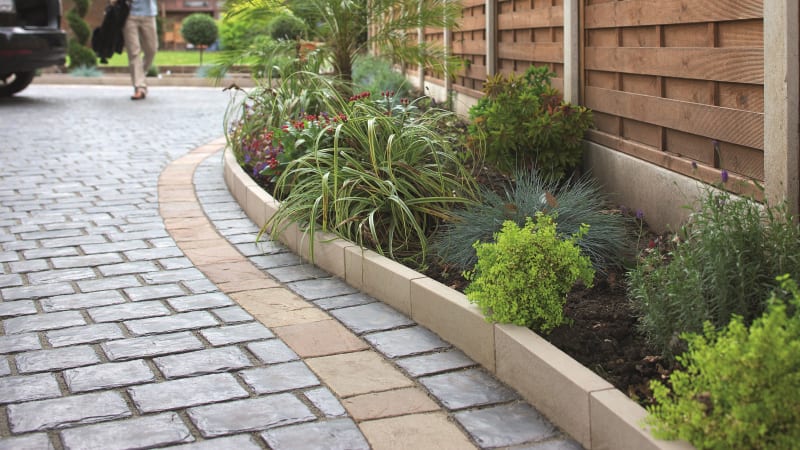
If you have a larger, more spacious garden with grassy areas through which you want to lay a stone path, think about using square or rectangular stones in a curved pattern. By contrasting the geometric shapes with a flowing, sweeping layout, you can create a really eye-catching space.
If you’d prefer a straight garden path, you can still bring in curved elements with a paving circle. These are excellent additions, especially to larger gardens, and can give the whole space a truly premium feel.
Mix and match paving
2. Mix and match paving

When you mix and match a variety of different materials, it gives a charmingly rustic look and feel that will be entirely unique to your home. The almost mosaic-like effect achieved by mixing different paving types together will add real character to your outdoor living space.
Generally, it’s best practice to keep to a smaller range of colours and materials, as too much variation could clash. It’s also important to think about matching the colours used in your garden path to the rest of your home’s exterior to make sure that everything feels co-ordinated.
From a safety perspective, it's advisable to choose materials that are of a similar height, so there's no chance of any trips or falls due to walking over an uneven surface.
3. Wooden decking style paths
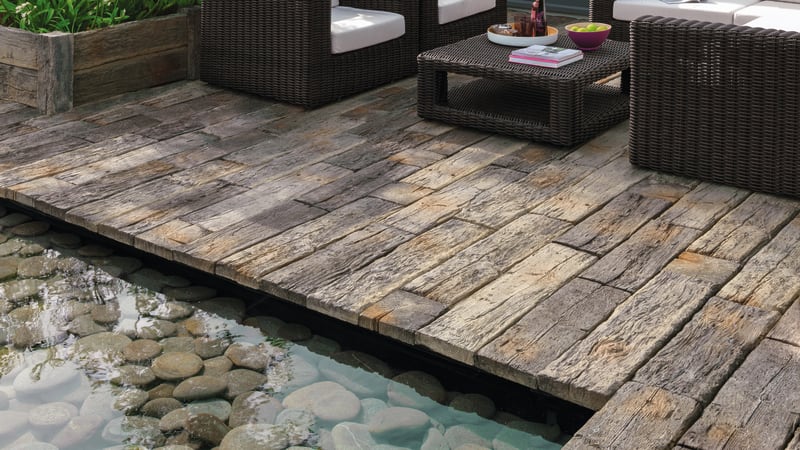
Wood-effect paving slabs provide a fantastic alternative to natural wood decking. Designed to replicate the organic look and feel of wooden planks, the Woodstone range of paving is ideal for creating an aesthetic that is instantly relaxing without any of the upkeep associated with genuine timber.
If you have a smaller garden, consider choosing a lighter-coloured paver as this will help to create the illusion of there being more space than there actually is. Stones inspired by the delicate tones of birch or oak will bring an instant sense of spaciousness into your outdoor living space, boasting a subtle elegance that will sit perfectly alongside a huge range of different garden design schemes.
4. Rustic overgrown paths
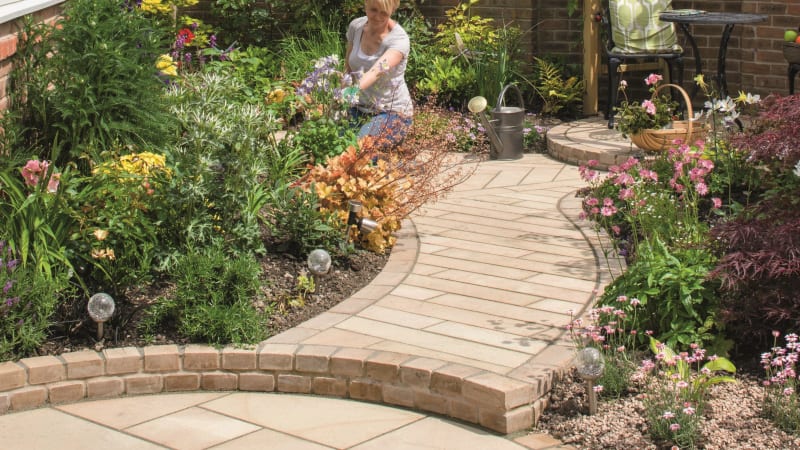
Relaxed, overgrown gardens are rapidly increasing in popularity, and not just because they require so little upkeep. Overgrown, meadow-inspired gardens are havens for a wide variety of wildlife, so consider letting your plants, shrubs, flowers, and herbs grow freely in between a natural stone or brick path. Just remember not to add any mortar between the bricks as this will prevent plant life from growing.
When paired with some upcycled outdoor furniture and hanging lights, an overgrown garden can be the perfect setting for a late-evening drink with friends or an adventure paradise for young kids.
5. Gravel garden paths
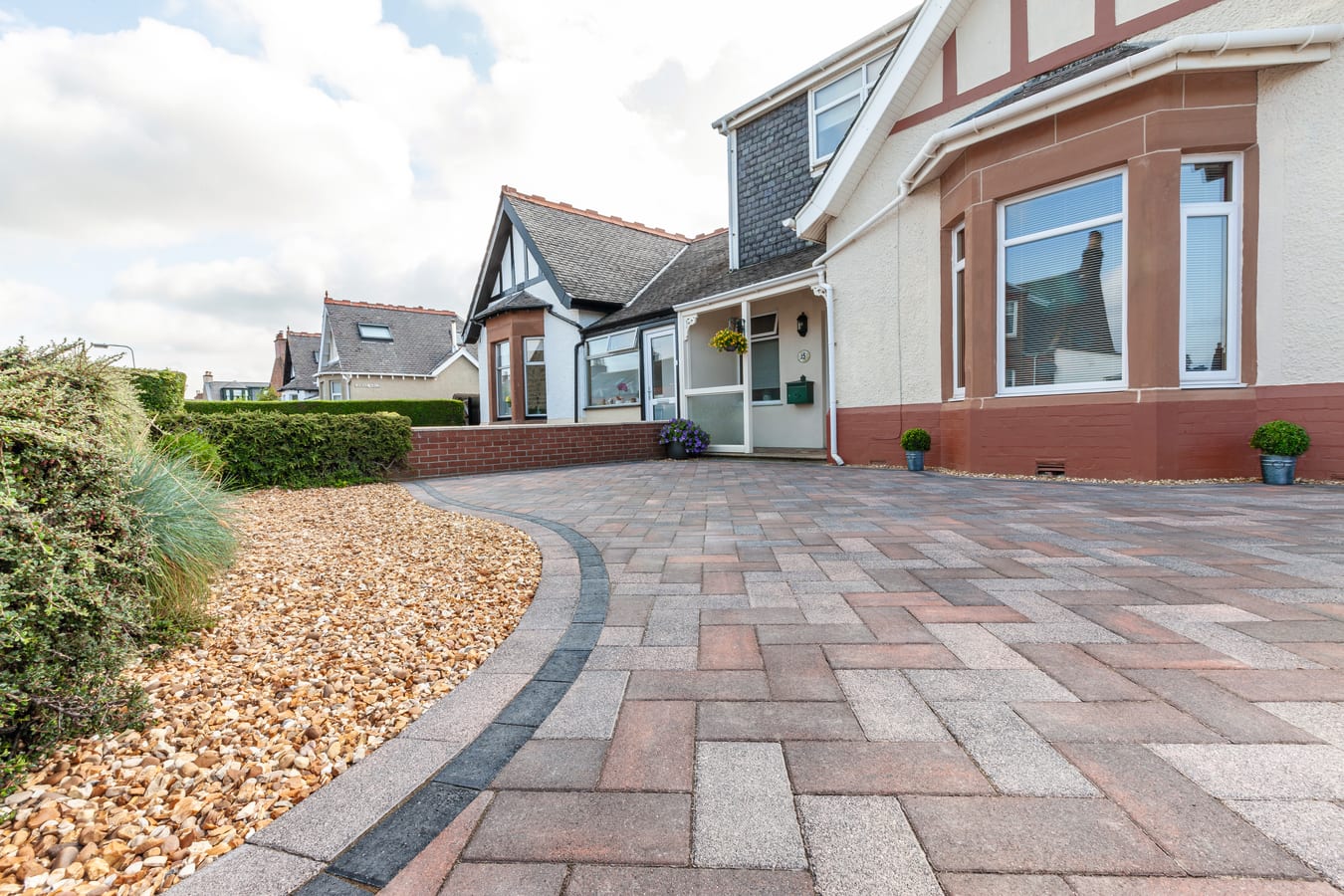
Gravel paths have long been a favourite of garden designers and landscapers all over the world. They are one of the quickest, easiest types of garden path to pay as all you need to do is pour your chosen gravel onto the pathway and distribute it evenly with a rake. Gravel paths also provide excellent scope for creativity, with lots of different colours and material finishes available for you to choose from.
6. Get floral and aromatic
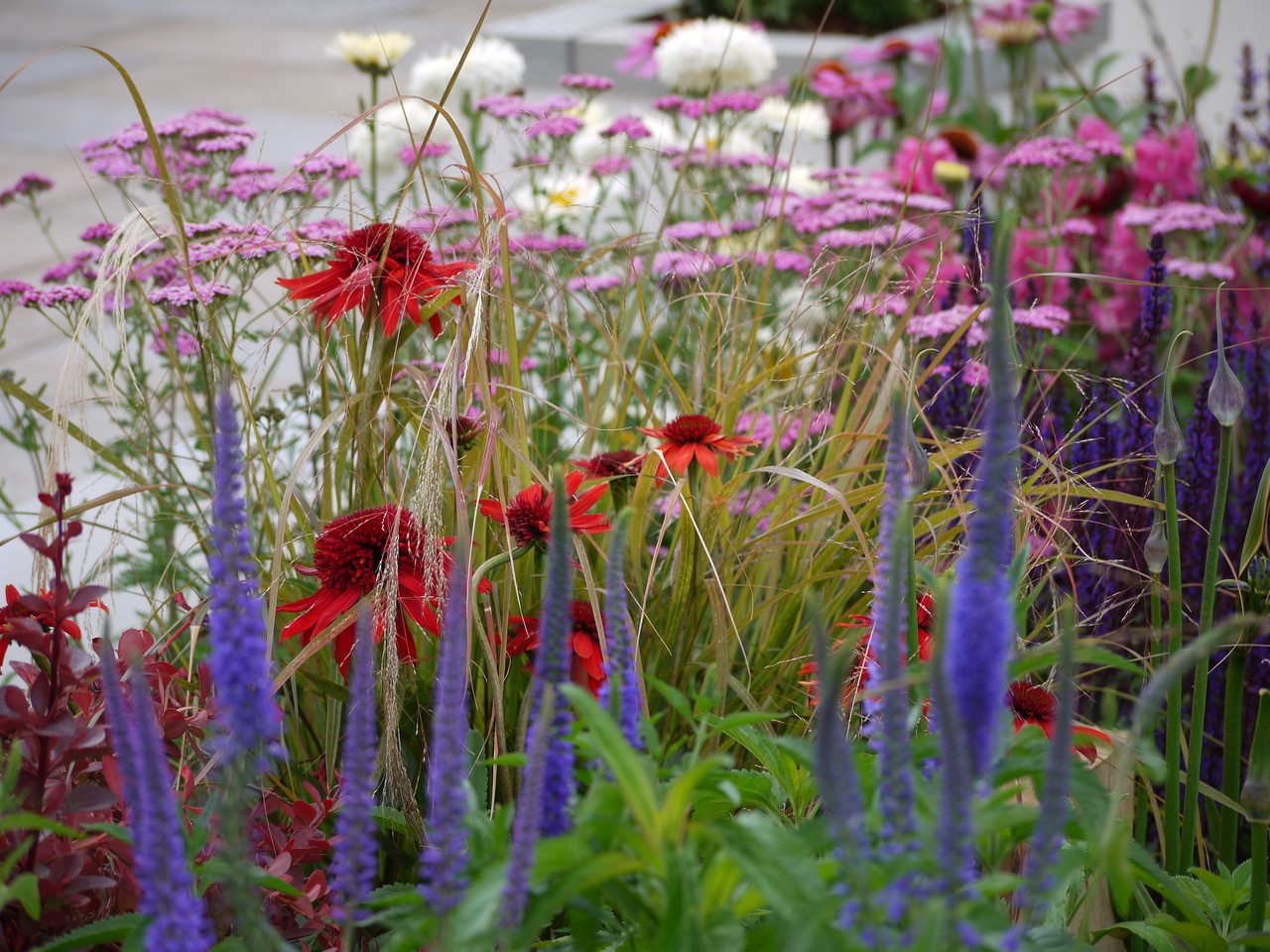
Regardless of the paving material you choose for your garden path, its entire look and feel can be greatly elevated with the addition of brightly-coloured flowers and aromatic herbs. You can either bed them directly into the ground along the sides of your path or plant them in pots for more flexibility on where they are placed.
Choose your flowers carefully, though, as different types will be better suited to different styles of garden. If your garden doesn’t get a lot of direct sunlight, be sure to pick varieties that do well in shadier areas. Or, if you want to keep garden maintenance to a minimum, think about choosing flowers that don’t need a lot of pruning, watering, and de-heading. To add another sensory element to your garden, choose flowers and herbs that give off relaxing aromas such as lilies, lavender, or rosemary.
7. Match paths with patios
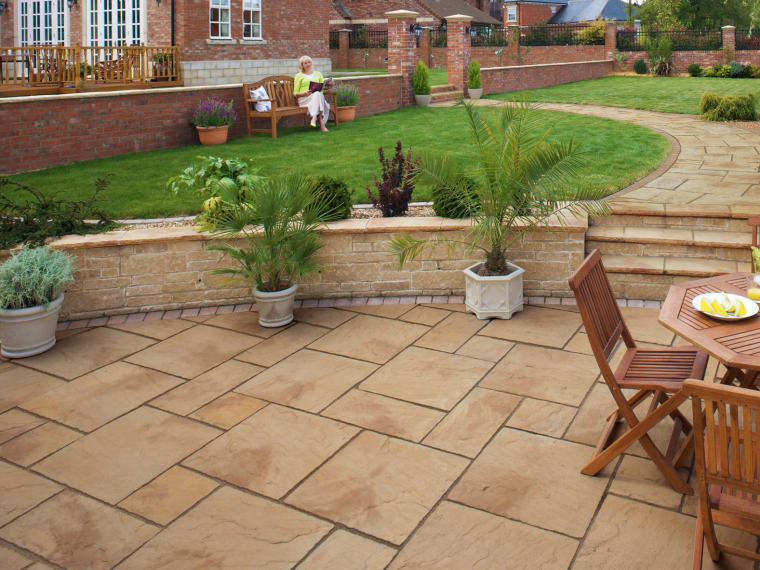
Complement any patio areas by building a garden path in the same material, whether it’s porcelain or paving stones.
Some beautiful garden path ideas that link to your patio area can be created from natrula stone or pea gravel. You may even wish to create a path using bricks to match the exterior of your house as this will help to make the overall look and feel of your outdoor living spaces feel much more coherent.
8. Lighting for garden paths
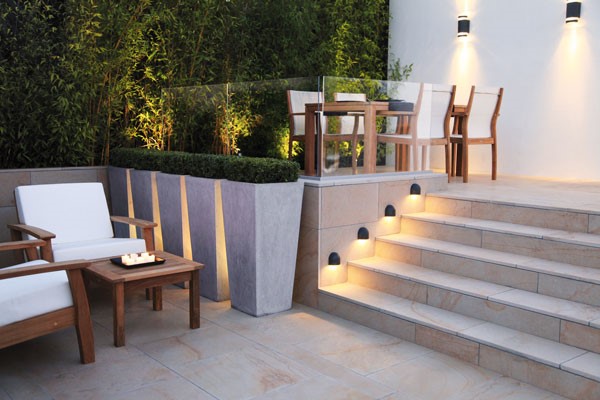
Nowadays, there is so much choice when it comes to outdoor lighting. Whether you want it recessed into your garden’s patio or paths, hanging from trees, fixed onto fences and garden walls, or sitting on top of low-lying retaining walls. lighting can transform the atmosphere of your garden and allow you to enjoy it long into the night.
Garden lights placed along a pathway provide a functional purpose, too, as they make sure that you are able to see the ground in front of you properly as you walk. Pathway lighting will also accentuate the design of your garden path, making it a great option for anyone wanting to make their new path the focal point of their home’s exterior.
9. Budget-friendly woodchip paths
For anyone looking for a cheaper garden path, consider using woodchips. These create a beautiful, rustic finish that is inspired by the natural feel of woodland paths that wind through forested areas. Additionally, woodchips are known to be a fantastic option for improving drainage and preventing water from pooling after heavy periods of rain - perfect for making sure that your garden path is usable all year round.
An added perk of creating a garden space with woodchip is the ground doesn't need to be level in order for a pathway to be created. So, if your outdoor spaces have uneven ground, slopes, or undulating surfaces, then this material is a winner.
10. Get inspired by styles from the Far East
If you’re wanting something a bit more zen, stepping stones are a great DIY garden path idea that can be incorporated into many types of landscaping schemes. You don't need a full Japanese-style garden to install a garden walkway like this, you can use a stepping stone path to add a twist to more traditional garden designs.
Using a stepping stone design is also practical if you have a garden prone to flooding in the damper British months. A path created from stepping stones with a raised profile will mean you can still walk through your garden when it is wet.
Choosing materials with a textured surface, such as riven paving slabs, will ensure that your pathway provides extra grip to help prevent slips and falls.
11. Incorporate large paving slabs

If you want to create something a bit different, consider using oversized paving slabs in your garden path. These are easy to lay and maintain and are available in a variety of different colours, shapes, and finishes.
These paths are perfect for a beginner who wants the look of a smart garden path without it being too formal, all while not having to worry about an overly complicated installation.
Check out our handy guide on how to cut paving slabs to help you transform your garden.
12. Reclaimed brick paths
By using reclaimed bricks instead of new ones, you can instantly create a garden path with a rustic, rural feel that not only looks amazing but is better for the environment, too. It's a win-win all around.
Picking up reclaimed brick is very easy, considering there is a wealth of brick suppliers online. You could even check out Gumtree or Facebook Marketplace, where sellers often place ads for a variety of brick colours, usually priced very cheap, too.
If you can only find a limited number of reclaimed bricks, you could think about using them alongside new bricks for the best of both worlds. Marshalls manufactures a wide range of different bricks and block pavers in colours and finishes to match landscaping schemes of all types, meaning you’ll be able to find ones that sit perfectly along any you’ve sourced elsewhere.
If you have other areas in your garden that use bricks, such as a garden wall, for example, you may want to consider using bricks of a similar colour and texture in your path to ensure the whole space feels consistent.
13. Diamond pattern paths
A diamond-shaped path will allow for a formal and sophisticated look if you have a small or narrow garden. Although it may look like a lot of hard work, diamond patterns are very easy to lay and look great in all weather. And, they don't require much maintenance because, even when a little overgrown, they still can look chic and effortless.
Using several different colours of stone in a diamond pattern is an easy way to create even more visual intrigue.
14. Mosaic garden paths

Sometimes called “crazy paving”, mosaic-inspired paths have been a firm favourite for decades. They use different shapes, sizes, and colours of stones to build a mis-matched pattern that is totally unique and will definitely bring a real sense of energy into your garden.
A mosaic stone path might take some time to achieve, but once you have matched up all the stones, the result can be magnificent. Laying paving slabs in this way can be incredibly forgiving, too, as any imperfections tend to be rendered invisible because there is no real consistency to the overall design.
Garden path ideas: What you need to consider
When thinking about various garden path ideas, there are important things to consider before you make your final decision. In this section, we'll talk you through some key factors you will need to understand before getting started.
Size
Firstly, it's essential to think about both the size of your garden and also the size of your new path. If you decide on a wide path, ensure your garden has enough space to carry it off. Otherwise, it could look entirely out of place and eat into your outdoor area.
A further factor affecting the size of your garden path is who will be using it. Make sure that the width of your path is sufficient to accommodate whoever and whatever it will be used for. Parents with younger children, for example, might want to design a wider path so that they can walk hand-in-hand with toddlers who may be less steady on their feet.
You will also need to measure the planned surface area of the pathway before buying any materials to ensure that you have enough to complete the project. Multiply the width by the length of your design to calculate the area it covers in metres squared - this will tell you how many paving slabs or bricks you need to buy.
Your home's aesthetic
When it comes to walkway ideas, you'll want to try and match your path to your home's aesthetic. Think about the architecture of your home, its exterior colours and materials, alongside the general look and feel of its design scheme.
The best garden paths are those that enhance the overall appearance of your home’s interior and outdoor living spaces by making them feel coherent, polished, and professional. You can achieve this by colour-matching the paving stones specified for your garden path to those used in your home’s exterior facade, perimeter walls, and patios.
Materials
When it comes to DIY garden path ideas, there's a multitude of materials readily available. If you want a level, uniform path, bricks or concrete paving stones will work best, but well-maintained gravel can also work if the ground is uneven.
When you decide on bricks or pavers, these are largely made up of similar colours, so you can get a good idea of what the finished path will look like. Natural stone paving will inevitably have slight differences in its tones and textures, being produced from natural materials that have veining details running throughout. This can help to create an impressive finish, as the stones you buy will be utterly unique to your home.
The weather may also be another deciding factor in what materials you choose for any garden path.. For instance, a gravel path will be less likely to freeze in the winter when it gets icy and, therefore, might be a more practical option if you are in a particularly cold area.
Safety
Ensuring that your garden path is as safe as possible for everyone that uses it - whether that be friends, children, or elderly family members - should always be something you take into consideration.
This means using appropriate materials that don't make negotiating the pathway overly complicated and potentially dangerous. It also means laying the pathway correctly and placing it in the right position, so it's certainly a job you shouldn't rush.
It’s worth noting that pathways made from stepping stones or gravel could be trickier for anyone with mobility issues, as these materials present greater trip hazards because they are less friendly to wheelchairs, walking frames, and impaired vision.
Garden walkways should always be properly maintained, which means investing time in keeping them clean, treated for moss and algae, and free from cracks. Remember, a path isn't just a decorative garden asset; it needs to be fully functional in all seasons.
For more guidance on how to lay a garden path, be sure to check out our guide.
Tools
If you are going to be laying the garden path yourself, consider what tools you will need to get the job done. Factor these into the overall cost of your path if you will need to buy some, otherwise you could end up with a half-finished project. Thankfully, you can pick up lots of gardening tools at very reasonable prices that will always stand you in good stead if you fancy trying out some other DIY garden ideas.
Create the perfect garden path with Marshalls
Here at Marshalls, our teams have over 130 years of experience in designing, manufacturing, delivering and caring for garden paths. We have a huge range of paving materials available, most of which are produced right here in the UK, meaning you can spend time choosing the ones that are perfect for your garden.
Marshalls paving and patio products are supplied with quality marks you can trust and expert support you can rely on, all to make your next landscaping project as easy and stress free as possible.
FAQs
What are the benefits of a garden path?
When it comes to getting around your garden, a garden path will provide the perfect balance of style and practical usage. A path is an important feature for exploring your own outdoor area. A garden path will largely determine how an area of outdoor land is experienced, mapping out the logistics of the journeys you'll take around it and drawing your attention to specific areas of interest such as fire pits, stone circles, water features, and more.
How do I maintain a garden path?
Depending on what materials you have used to create your garden path, they can be straightforward to care for. Remember, the more durable the materials you use, the longer your path will last. Be sure to give your path a decent scrub every few months to eliminate moss and dirt.
For more tips and tricks on how to keep your garden path looking its best all year round, read our how-to guide on maintaining stone paving..
Why is spending time in the garden so good for you?
Spending time in the garden is a great way to take time for yourself and to reflect on nature. It also gives a sense of personal achievement when relaxing in an outdoor area you have crafted. Plus, there are other multiple mental health benefits of spending time outdoors, such as reducing stress and anxiety as well as alleviating depression.
What other ways can I transform my garden besides with a path?
There are numerous ways to breathe new life into just about any garden. From laying a low-maintenance patio area so your garden will look fresh all year round to investing in new garden walling, there are many ways to improve the overall look and feel of your outdoor area.
Thinking of your garden as simply an extension of your home should help to inspire and spark your imagination and get your creative side flowing.
Read more about our range of garden path stones for your outdoor walkway.










